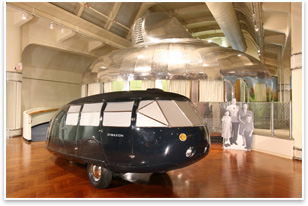 SUSTAINABILITY SUSTAINABILITY
The First Green Architect?
by Michael J. Crosbie, PhD, AIA
Contributing Editor
Summary: This summer there is a celebration of the ideas and work of Buckminster Fuller in the form of an exhibit, “Starting with the Universe,” on view at the Whitney Museum of American Art in New York City through September 21. “Bucky” Fuller was many things: engineer, scientist, visionary, philosopher—and as this exhibit shows, he might also be considered the first green architect. Most of us are familiar with Fuller’s landmark projects, such as the geodesic dome (now found around the world), the Dymaxion car, and the Dymaxion house (neither of which ever really made a dent in our built environment). None of these artifacts would elevate Fuller to the rank for first green architect. He is worthy of that distinction thanks to how he thought about the universe and the world we live in. Rather than any green technology or sustainable system, we’re indebted to Fuller as the first green architect because his ideas have had a lasting impact on our very concept of sustainability.
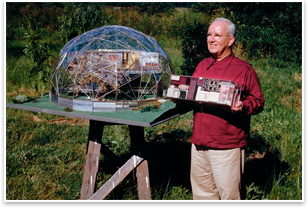 Fuller popularized the term “Spaceship Earth.” In many ways that very notion captures the critical importance of sustainability. Hurtling through space, our blue and green sphere is a closed system, upon whose regulation life depends. Fuller helped us to see the connections between our actions and environmental consequences. A lateral thinker extraordinaire, he provided the conceptual underpinnings of sustainable architecture as part of a larger network of relationships that can be tuned to do more with less. Doing more with less was an idea that guided Fuller in his wide-ranging interests, and the word “dymaxion” distilled the notion beautifully: dynamic, maximum, tension. All three terms are inherent in Fuller’s material frugality, a New England trait that ran deep in this descendent of old Yankee stock. Getting the most out of the least is a clever notion of maximizing a material. Tension is a quality of anything stretched to its most efficient limit. Together, they create a dynamism that feeds upon itself, multiplying the rewards of sustainability with ripple effects throughout the environment. Fuller popularized the term “Spaceship Earth.” In many ways that very notion captures the critical importance of sustainability. Hurtling through space, our blue and green sphere is a closed system, upon whose regulation life depends. Fuller helped us to see the connections between our actions and environmental consequences. A lateral thinker extraordinaire, he provided the conceptual underpinnings of sustainable architecture as part of a larger network of relationships that can be tuned to do more with less. Doing more with less was an idea that guided Fuller in his wide-ranging interests, and the word “dymaxion” distilled the notion beautifully: dynamic, maximum, tension. All three terms are inherent in Fuller’s material frugality, a New England trait that ran deep in this descendent of old Yankee stock. Getting the most out of the least is a clever notion of maximizing a material. Tension is a quality of anything stretched to its most efficient limit. Together, they create a dynamism that feeds upon itself, multiplying the rewards of sustainability with ripple effects throughout the environment.
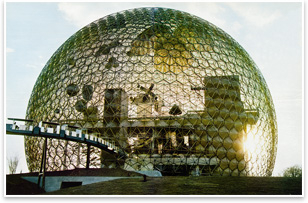 The geodesic dome is perhaps the architectural expression that is most faithful to Fuller’s concept of doing more with less. Fuller believed that the triangular model for the geodesic’s basic building block was modeled on structures found in nature. In this way, Fuller was attuned to bio-mimicry in architectural design. As a pure structural ideal the geodesic dome is elegant, efficient, and lightweight. But as an architectural realization, the geodesic dome has never been quite believable. When translated into an actual building, the dome is prone to leaks in the plethora of its structural connections. The dome’s spatial envelope is not the most efficient when it comes to heating and cooling. As a beautiful, pure form, the geodesic dome always presents the designer with the challenge of entry—where do you violate the geometry to get inside? The geodesic dome is perhaps the architectural expression that is most faithful to Fuller’s concept of doing more with less. Fuller believed that the triangular model for the geodesic’s basic building block was modeled on structures found in nature. In this way, Fuller was attuned to bio-mimicry in architectural design. As a pure structural ideal the geodesic dome is elegant, efficient, and lightweight. But as an architectural realization, the geodesic dome has never been quite believable. When translated into an actual building, the dome is prone to leaks in the plethora of its structural connections. The dome’s spatial envelope is not the most efficient when it comes to heating and cooling. As a beautiful, pure form, the geodesic dome always presents the designer with the challenge of entry—where do you violate the geometry to get inside?
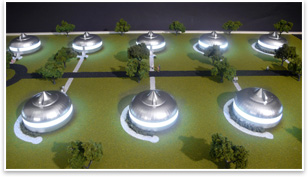 Fuller’s concepts of efficiency and the interconnectedness of systems mark him as a path-breaker in sustainability. His unswerving faith that all problems could be solved by applying the right technology is a product of his time and place—a very Modern approach to negotiating our place in the world. That belief in technology is far less certain for us today. Sustainable design and architecture reflect this. Technological fixes to problems caused by our unchecked application of technology are more suspect now than they were just a decade or so ago. We will not get ourselves out of the situation purely by dreaming up new gizmos and applying them to our buildings. Our built environment will be far better served by the more comprehensive, conceptual nature of Bucky Fuller’s view of the universe: that it is made of delicate, sophisticated relationships that need to be respected and studied. Within them are clues to the ways of improving the environmental performance of architecture. Fuller’s concepts of efficiency and the interconnectedness of systems mark him as a path-breaker in sustainability. His unswerving faith that all problems could be solved by applying the right technology is a product of his time and place—a very Modern approach to negotiating our place in the world. That belief in technology is far less certain for us today. Sustainable design and architecture reflect this. Technological fixes to problems caused by our unchecked application of technology are more suspect now than they were just a decade or so ago. We will not get ourselves out of the situation purely by dreaming up new gizmos and applying them to our buildings. Our built environment will be far better served by the more comprehensive, conceptual nature of Bucky Fuller’s view of the universe: that it is made of delicate, sophisticated relationships that need to be respected and studied. Within them are clues to the ways of improving the environmental performance of architecture.
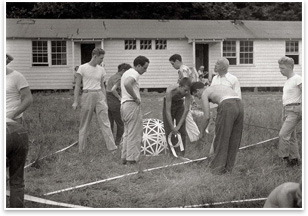
|



 Fuller popularized the term “Spaceship Earth.” In many ways that very notion captures the critical importance of sustainability. Hurtling through space, our blue and green sphere is a closed system, upon whose regulation life depends. Fuller helped us to see the connections between our actions and environmental consequences. A lateral thinker extraordinaire, he provided the conceptual underpinnings of sustainable architecture as part of a larger network of relationships that can be tuned to do more with less. Doing more with less was an idea that guided Fuller in his wide-ranging interests, and the word “dymaxion” distilled the notion beautifully: dynamic, maximum, tension. All three terms are inherent in Fuller’s material frugality, a New England trait that ran deep in this descendent of old Yankee stock. Getting the most out of the least is a clever notion of maximizing a material. Tension is a quality of anything stretched to its most efficient limit. Together, they create a dynamism that feeds upon itself, multiplying the rewards of sustainability with ripple effects throughout the environment.
Fuller popularized the term “Spaceship Earth.” In many ways that very notion captures the critical importance of sustainability. Hurtling through space, our blue and green sphere is a closed system, upon whose regulation life depends. Fuller helped us to see the connections between our actions and environmental consequences. A lateral thinker extraordinaire, he provided the conceptual underpinnings of sustainable architecture as part of a larger network of relationships that can be tuned to do more with less. Doing more with less was an idea that guided Fuller in his wide-ranging interests, and the word “dymaxion” distilled the notion beautifully: dynamic, maximum, tension. All three terms are inherent in Fuller’s material frugality, a New England trait that ran deep in this descendent of old Yankee stock. Getting the most out of the least is a clever notion of maximizing a material. Tension is a quality of anything stretched to its most efficient limit. Together, they create a dynamism that feeds upon itself, multiplying the rewards of sustainability with ripple effects throughout the environment. The geodesic dome is perhaps the architectural expression that is most faithful to Fuller’s concept of doing more with less. Fuller believed that the triangular model for the geodesic’s basic building block was modeled on structures found in nature. In this way, Fuller was attuned to bio-mimicry in architectural design. As a pure structural ideal the geodesic dome is elegant, efficient, and lightweight. But as an architectural realization, the geodesic dome has never been quite believable. When translated into an actual building, the dome is prone to leaks in the plethora of its structural connections. The dome’s spatial envelope is not the most efficient when it comes to heating and cooling. As a beautiful, pure form, the geodesic dome always presents the designer with the challenge of entry—where do you violate the geometry to get inside?
The geodesic dome is perhaps the architectural expression that is most faithful to Fuller’s concept of doing more with less. Fuller believed that the triangular model for the geodesic’s basic building block was modeled on structures found in nature. In this way, Fuller was attuned to bio-mimicry in architectural design. As a pure structural ideal the geodesic dome is elegant, efficient, and lightweight. But as an architectural realization, the geodesic dome has never been quite believable. When translated into an actual building, the dome is prone to leaks in the plethora of its structural connections. The dome’s spatial envelope is not the most efficient when it comes to heating and cooling. As a beautiful, pure form, the geodesic dome always presents the designer with the challenge of entry—where do you violate the geometry to get inside? Fuller’s concepts of efficiency and the interconnectedness of systems mark him as a path-breaker in sustainability. His unswerving faith that all problems could be solved by applying the right technology is a product of his time and place—a very Modern approach to negotiating our place in the world. That belief in technology is far less certain for us today. Sustainable design and architecture reflect this. Technological fixes to problems caused by our unchecked application of technology are more suspect now than they were just a decade or so ago. We will not get ourselves out of the situation purely by dreaming up new gizmos and applying them to our buildings. Our built environment will be far better served by the more comprehensive, conceptual nature of Bucky Fuller’s view of the universe: that it is made of delicate, sophisticated relationships that need to be respected and studied. Within them are clues to the ways of improving the environmental performance of architecture.
Fuller’s concepts of efficiency and the interconnectedness of systems mark him as a path-breaker in sustainability. His unswerving faith that all problems could be solved by applying the right technology is a product of his time and place—a very Modern approach to negotiating our place in the world. That belief in technology is far less certain for us today. Sustainable design and architecture reflect this. Technological fixes to problems caused by our unchecked application of technology are more suspect now than they were just a decade or so ago. We will not get ourselves out of the situation purely by dreaming up new gizmos and applying them to our buildings. Our built environment will be far better served by the more comprehensive, conceptual nature of Bucky Fuller’s view of the universe: that it is made of delicate, sophisticated relationships that need to be respected and studied. Within them are clues to the ways of improving the environmental performance of architecture.
